Populus grandidentata (Big-tooth Aspen)
| Also known as: | Large-tooth Aspen |
|---|---|
| Genus: | Populus |
| Family: | Salicaceae (Willow) |
| Life cycle: | perennial woody |
| Origin: | native |
| Habitat: | part shade, shade, sun; |
| Bloom season: | April - May |
| Plant height: | 50 to 95 feet |
| Wetland Indicator Status: | GP: FACU MW: FACU NCNE: FACU |
| MN county distribution (click map to enlarge): |  |
| National distribution (click map to enlarge): |  |
Pick an image for a larger view. See the glossary for icon descriptions.
Detailed Information
Flower: 


Male and female flowers are on separate trees (dioecious) in hanging clusters (catkins) from the leaf axils of 1 year old branch twigs. Male catkins are 1 to 3½ inches long with tiers of red stamens. Female catkins are 1¼ to 3 inches long with red stigmas.
Leaves and stems: 

![[photo of leaves]](/udata/r9ndp23q/trees/populus-grandidentata-t.jpg) Leaves are alternate and simple with a flat leaf stalk. The blade is 2 to 4 inches long and 1¾ to 3½ inches wide, oval to broadly egg-shaped, rounded or pointed at the tip, rounded at the base. Large, coarse, blunt teeth are all along the edges. Both leaf surfaces have white woolly hairs when emerging, the upper less so than below and turning smooth and dark green, the lower surface light green and shedding most of the hairs at maturity.
Leaves are alternate and simple with a flat leaf stalk. The blade is 2 to 4 inches long and 1¾ to 3½ inches wide, oval to broadly egg-shaped, rounded or pointed at the tip, rounded at the base. Large, coarse, blunt teeth are all along the edges. Both leaf surfaces have white woolly hairs when emerging, the upper less so than below and turning smooth and dark green, the lower surface light green and shedding most of the hairs at maturity.
![[photo of upper trunk]](/udata/r9ndp23q/pd3/populus-grandidentata-005-t.jpg) Twigs emerge dense, woolly white, turning greenish brown and partially to mostly hairless by end of summer. Buds are round, ¼ to 3/8 inch long and pointed, white from wooly hairs, reddish brown underneath. Bark is smooth and thin, green or yellowish gray on younger branches and the upper trunk. Older bark at the base of trunk becomes thick and dark gray/brown with coarse ridges and deep furrows.The trunk can get up to 24-inch diameter at breast height.
Twigs emerge dense, woolly white, turning greenish brown and partially to mostly hairless by end of summer. Buds are round, ¼ to 3/8 inch long and pointed, white from wooly hairs, reddish brown underneath. Bark is smooth and thin, green or yellowish gray on younger branches and the upper trunk. Older bark at the base of trunk becomes thick and dark gray/brown with coarse ridges and deep furrows.The trunk can get up to 24-inch diameter at breast height.
Fruit: 
The fruits are green, narrowly round capsules densely arranged on the long pendulous catkins. The capsules split into two halves releasing the cottony seed.
Notes:
Bigtooth Aspen is a tall, narrow-crowned tree throughout most of Minnesota's upland forests. It's a clonal species that spreads by root suckers, though its colonies are much smaller and far less frequent than the similar Quaking Aspen (Populus tremuloides). Like Quaking Aspen, Bigtooth Aspen leaves have a flat stalk that causes the leaves to flutter in the wind, but its leaves are also more egg shaped with large, blunt teeth. Its bark is similar as well but it stays a darker greenish gray to nearly olive where Quaking Aspen's bark is a light greenish gray to nearly white. Bigtooth Aspen's fall color can be deep yellow but it can also display foliage that is deeply orange with tinges of red.
Native Plant Nurseries, Restoration and Landscaping Services ↓
More photos
 Big-tooth Aspen trees
Big-tooth Aspen trees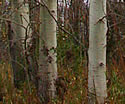 a stand of Big-tooth Aspen
a stand of Big-tooth Aspen fall color, with Red Oak
fall color, with Red Oak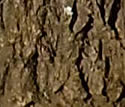 old tree trunk
old tree trunk Big-tooth Aspen with Quaking Aspen
Big-tooth Aspen with Quaking Aspen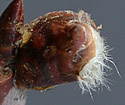 twig and catkin buds
twig and catkin buds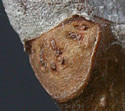 woolly twig, leaf buds and leaf scar
woolly twig, leaf buds and leaf scar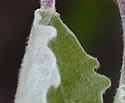 fresh spring leaves with white undersides
fresh spring leaves with white undersides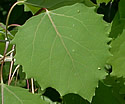 later season leaves
later season leaves
Photos courtesy Peter M. Dziuk taken in Anoka and Ramsey counties, and in North Dakota.
Comments
Have you seen this plant in Minnesota, or have any other comments about it?
on: 2017-09-27 13:36:31
There's a grove of large Populus grandidentata (Big-tooth Aspen) growing at the end of Peteler Lane. Populus grandidentata (Big-tooth Aspen) grows in Lone Lake Park in Minnetonka.
on: 2019-08-31 03:30:58
Many of Big-tooth Aspen in my woods. After a blowdown, many aspen filled in open areas.
on: 2020-05-26 20:11:58
About 30 years ago I bought and planted about 75 hybrid poppel trees from the Isanti soil conservation district. I was told that they were "bigtooth" but I'm not sure. Had that species been developed at that time. They sure look like they could be. I'm wondering about the lifespan of this tree as some of them are starting to die off and others tops are showing signs of starting to die back. Is this a tree with a 30-35 year expected life?
on: 2022-06-13 06:15:01
There has been more big tooth catkin fluff than I can ever remember this year. Within the past few weeks, at times it almost appeared like snow blowing in the wind and a layer covering leaves in the woods, along edges of roads. Most people have been blaming cottowoods, but I believe they are rare in this area. You can see the white fluff clinging to the long catkins, then dropping to the ground.
on: 2022-07-29 16:08:16
A few trees in a sugar maple and paper birch forest along the Superior Hiking Trail between Finland and Little Marais.






